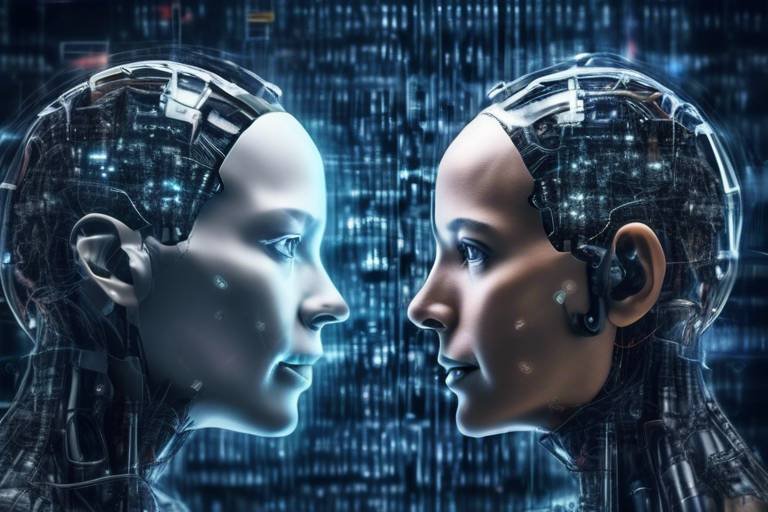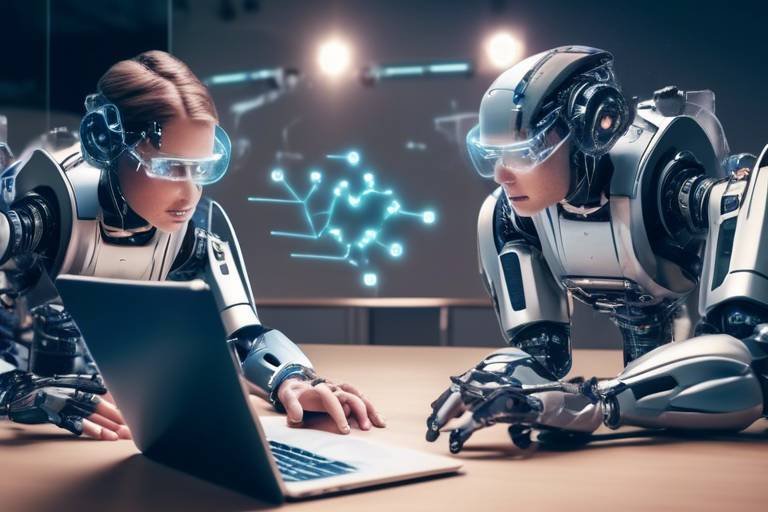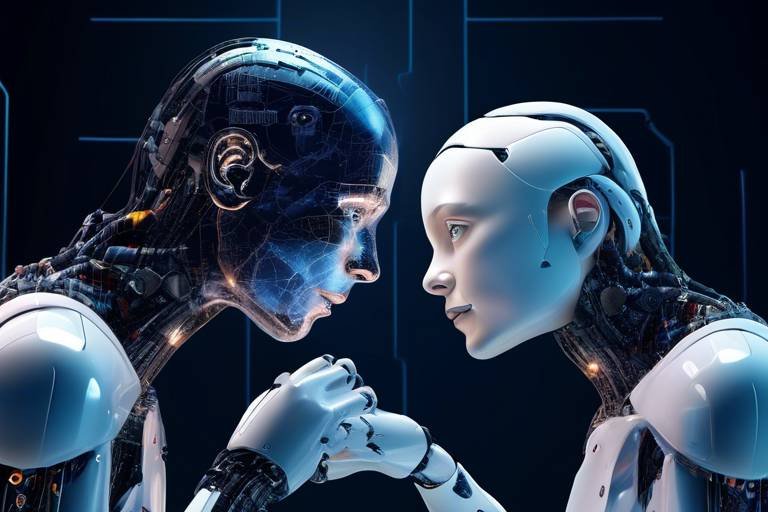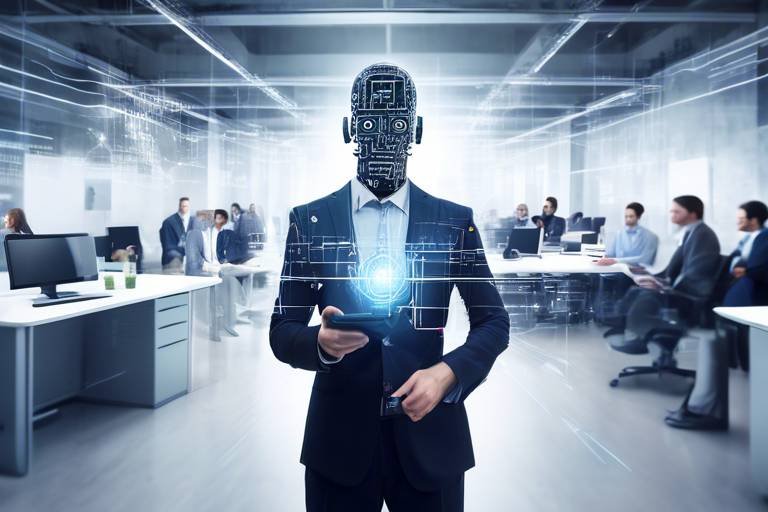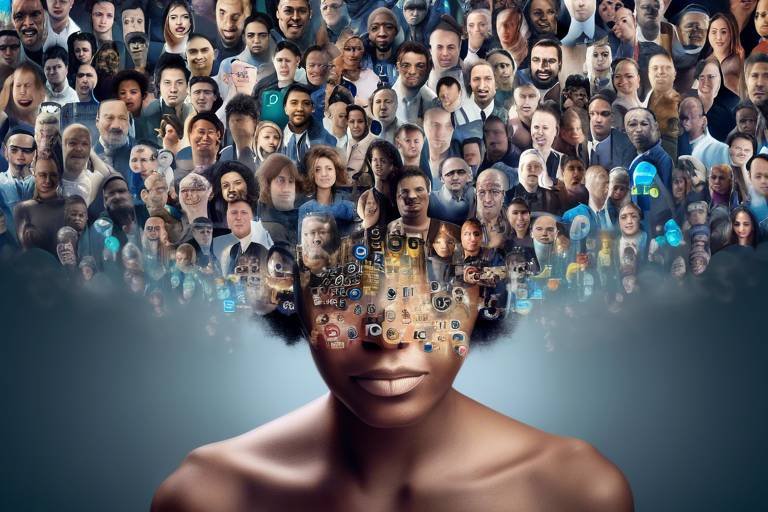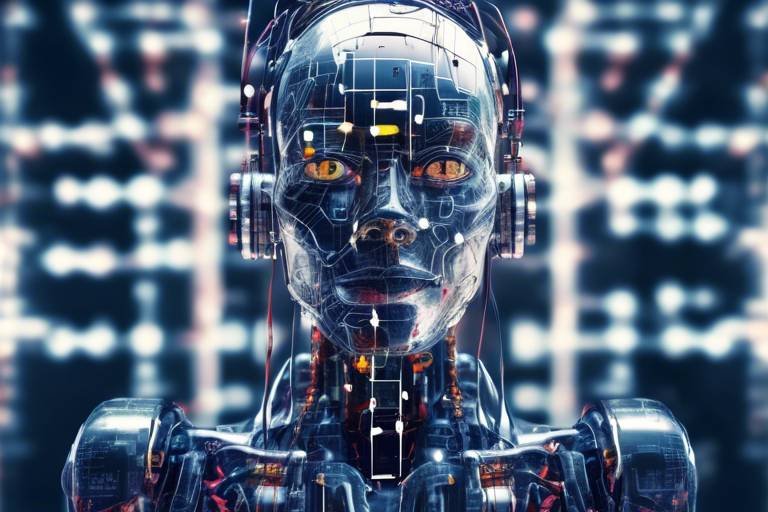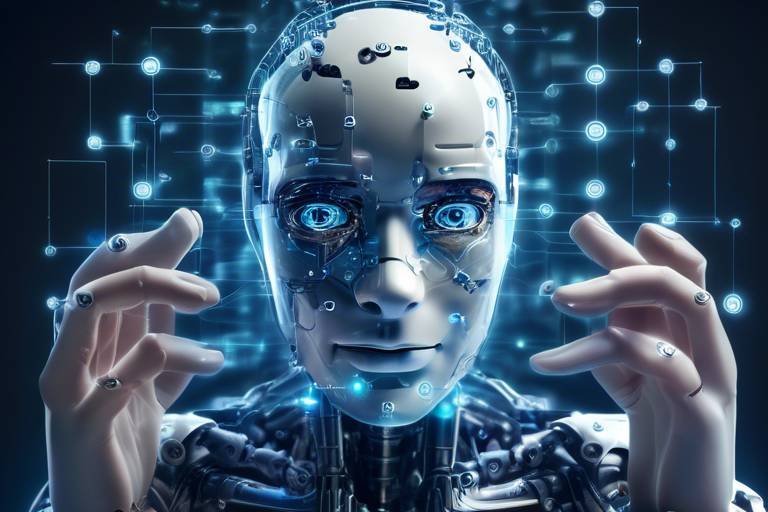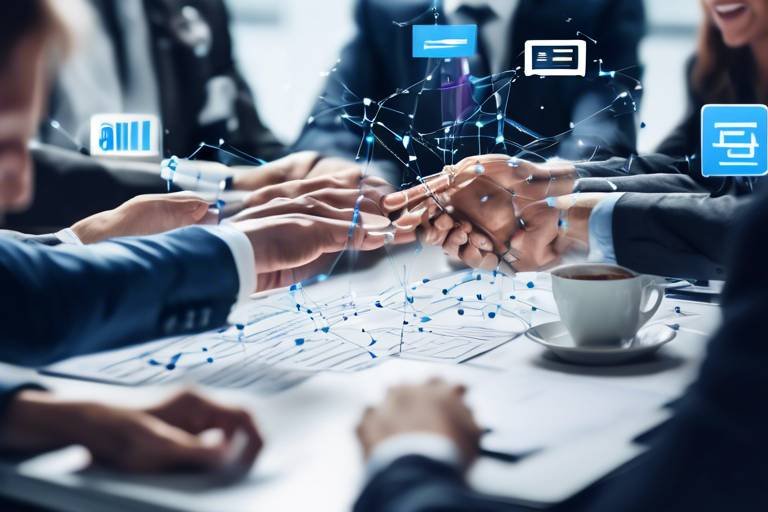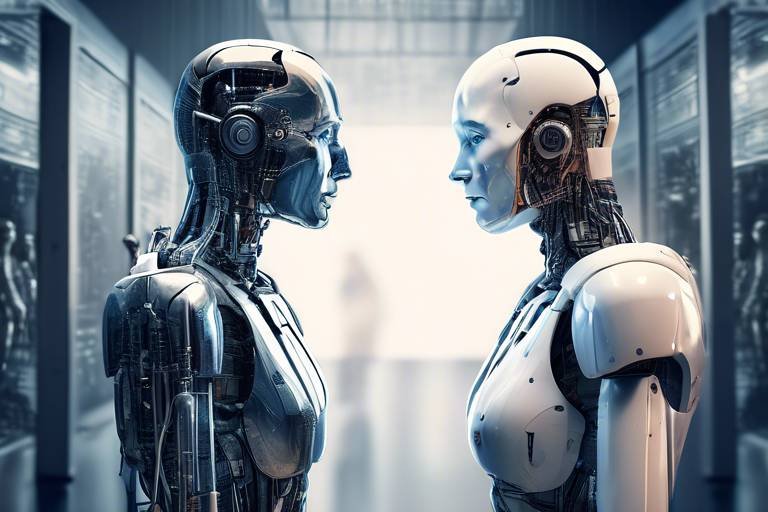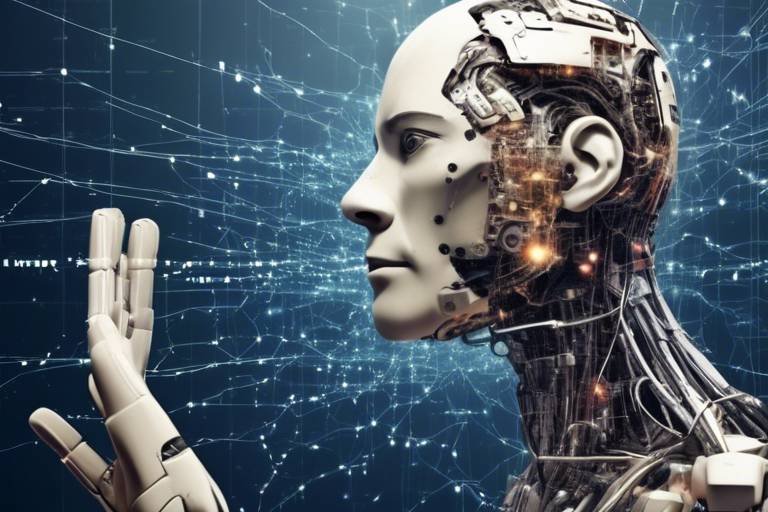AI & Human Collaboration: A Symbiotic Relationship
In today's rapidly evolving technological landscape, the collaboration between artificial intelligence (AI) and humans has emerged as a pivotal force driving innovation and efficiency across various sectors. This partnership is not merely a trend; it represents a symbiotic relationship where both entities leverage their unique strengths to achieve outcomes that neither could accomplish alone. Imagine AI as a powerful engine, capable of processing vast amounts of data, while humans are the skilled drivers, steering that engine towards meaningful goals. Together, they can navigate the complexities of modern challenges, creating solutions that are both innovative and effective.
The essence of this collaboration lies in understanding how AI can complement human capabilities. While AI excels in data analysis and pattern recognition, humans bring creativity, emotional intelligence, and ethical considerations to the table. This fusion allows for a more holistic approach to problem-solving, where technology enhances human intuition and experience. As we delve deeper into this relationship, it becomes clear that the future is not about AI replacing humans but rather about humans and AI working hand in hand to push the boundaries of what is possible.
Consider the healthcare industry, for example. AI can analyze medical records and identify trends that may go unnoticed by human practitioners. However, it is the human touch—empathy, understanding, and ethical judgment—that ensures patient care remains at the forefront. In this context, AI acts as a powerful assistant, providing doctors with insights that enhance their decision-making process while allowing them to maintain the essential human connection with their patients.
Moreover, the collaboration between AI and humans is not limited to healthcare. Industries such as finance, education, and manufacturing are also experiencing transformative changes. In finance, AI algorithms can predict market trends and assist in risk management, while human analysts interpret these insights to make strategic decisions. In education, AI can personalize learning experiences, adapting to individual student needs, while teachers provide the guidance and mentorship essential for holistic development.
As we explore the potential of AI and human collaboration, it's crucial to recognize that the journey is not without its challenges. Issues such as ethical considerations, trust, and effective communication must be addressed to fully harness the benefits of this partnership. However, with a focus on transparency and accountability, we can build a future where AI and humans coexist harmoniously, driving progress and innovation.
- What is AI-human collaboration? - It refers to the partnership between AI technologies and human capabilities to achieve better outcomes.
- How does AI enhance human decision-making? - AI analyzes large datasets quickly, offering insights that support informed choices.
- What are the ethical concerns surrounding AI? - Issues include fairness, accountability, and transparency in AI systems.
- Will AI replace human jobs? - AI is expected to transform jobs, emphasizing collaboration rather than replacement.
- What industries benefit from AI-human collaboration? - Healthcare, finance, education, and manufacturing are just a few examples.

The Evolution of AI and Human Partnership
The journey of artificial intelligence (AI) has been nothing short of fascinating, resembling a thrilling rollercoaster ride filled with twists, turns, and unexpected drops. From its inception, AI has been intricately linked with human ingenuity, evolving through the collective efforts of brilliant minds. The partnership between AI and humans is not just a modern phenomenon; it has historical roots that trace back several decades. Understanding this evolution sheds light on how our collaboration has shaped the capabilities of AI, leading to innovative solutions that were once the stuff of science fiction.
In the early days, AI was primarily viewed as a tool—a sophisticated calculator designed to perform specific tasks. However, as technology progressed, it became clear that AI could do more than just crunch numbers. Researchers began to realize that by integrating human-like reasoning and learning capabilities, machines could tackle complex problems. This was a pivotal moment in the evolution of AI, where human input was crucial in teaching machines how to think, learn, and adapt.
One of the most significant milestones in this partnership occurred during the 1980s and 1990s with the advent of expert systems. These systems were designed to mimic human decision-making in specialized fields such as medicine and engineering. For instance, in healthcare, expert systems could analyze patient symptoms and suggest potential diagnoses, effectively augmenting the expertise of human doctors. This collaboration not only enhanced the accuracy of diagnoses but also improved patient outcomes, showcasing the power of AI when combined with human intuition and experience.
Fast forward to the 21st century, and we find ourselves in an era where AI technologies like machine learning and natural language processing are revolutionizing industries. The interplay between AI and human capabilities has become more sophisticated, leading to a new wave of innovations. For instance, in creative fields, AI algorithms can generate music, art, and even literature, while human creators provide the emotional depth and context that machines lack. This creative synergy is pushing the boundaries of what we consider possible, transforming the way we approach art and creativity.
Moreover, as AI continues to evolve, its partnership with humans is becoming increasingly essential in various sectors. In business, AI tools are now used for data analysis, customer service, and even marketing strategies. The ability to analyze vast amounts of data quickly allows organizations to make informed decisions, while human oversight ensures that these decisions align with ethical standards and societal values. This collaboration is not just about efficiency; it's about creating a more holistic approach to problem-solving.
To illustrate the evolution of AI and human partnership, consider the following table that summarizes key milestones:
| Year | Milestone | Impact on Human-AI Collaboration |
|---|---|---|
| 1956 | Dartmouth Conference | Birth of AI as a field; focus on human-like reasoning. |
| 1980s | Expert Systems | AI assists in specialized decision-making, enhancing human expertise. |
| 2010s | Machine Learning Boom | AI begins to learn from data, improving its applications across industries. |
| 2020s | Creative AI | Collaboration in creative fields, blending human emotion with AI capabilities. |
In conclusion, the evolution of AI and human partnership is a testament to our ability to innovate and adapt. As we continue to explore the potential of AI, it’s essential to recognize that this journey is not a solitary one. Rather, it is a symbiotic relationship that thrives on collaboration, creativity, and shared goals. Together, we can unlock new possibilities and shape a future where AI enhances the human experience rather than replacing it.
- What is the history of AI? AI has evolved from basic computational tools in the 1950s to advanced systems capable of learning and creating in the 21st century.
- How does AI enhance human creativity? AI can analyze data and generate ideas, while humans provide the emotional and contextual depth necessary for artistic expression.
- What are the ethical concerns surrounding AI? Ethical considerations include fairness, accountability, and the transparency of AI systems in decision-making processes.

Benefits of AI-Human Collaboration
The collaboration between artificial intelligence (AI) and humans opens up a world of possibilities that can significantly enhance various aspects of our lives. Imagine a partnership where the analytical prowess of AI meets the creative and emotional intelligence of humans. This dynamic duo not only boosts productivity but also fosters innovation in ways that were previously unimaginable. By combining the strengths of both entities, we can achieve remarkable outcomes that transcend traditional boundaries.
One of the most profound benefits of this collaboration is the enhancement of decision-making. In today's data-driven world, the ability to analyze vast amounts of information quickly is crucial. AI excels at processing and interpreting data at lightning speed, providing insights that can support human decision-making. For instance, in industries like finance or healthcare, AI can sift through extensive datasets to identify trends, anomalies, and potential risks, allowing humans to make more informed choices. With AI's analytical capabilities, decision-makers can focus on strategic thinking and creativity, rather than getting bogged down in data analysis.
When it comes to decision-making, AI acts as a powerful ally. By providing data-driven insights, AI technologies can uncover patterns and trends that humans might overlook. This is particularly beneficial in fields such as marketing, where understanding consumer behavior is key. For example, AI can analyze customer interactions across various platforms, revealing insights into preferences and behaviors that inform targeted marketing strategies. This not only improves the effectiveness of campaigns but also enhances customer satisfaction.
Moreover, AI's role in risk assessment cannot be understated. In an era where businesses face numerous uncertainties, the ability to evaluate risks accurately is vital. Collaborative efforts between AI and humans allow organizations to assess potential risks more comprehensively. AI can analyze historical data and simulate various scenarios, providing a clearer picture of potential outcomes. This enables teams to make confident decisions, even in the face of ambiguity. Ultimately, the partnership between AI and humans leads to more robust and informed decision-making processes.
But it’s not just about numbers and data; the collaboration also sparks creative synergy. AI's computational power can complement human creativity, leading to innovative solutions and artistic expressions. Consider the world of design and art—AI tools are now being used to generate unique designs, suggest color palettes, and even create music. This fusion of technology and human creativity pushes the boundaries of what is possible. For instance, artists can use AI to explore new styles or techniques, resulting in groundbreaking works that challenge conventional norms.
Furthermore, the integration of AI into creative processes can lead to enhanced collaboration across teams. By automating routine tasks, AI frees up time for creative professionals to focus on higher-level thinking and innovation. This not only boosts productivity but also encourages a culture of collaboration where ideas can flow freely. As a result, organizations can foster environments that prioritize creativity and innovation, ultimately leading to greater success.
In conclusion, the benefits of AI-human collaboration are vast and varied. From enhanced decision-making and risk assessment to the fusion of creativity and technology, the potential for improved outcomes is immense. As we continue to explore this partnership, the possibilities for innovation are limited only by our imagination. As we embrace this collaborative future, it's essential to recognize the unique strengths that both AI and humans bring to the table, ensuring that we harness their combined power for the greater good.
- What are the main benefits of AI-human collaboration?
The main benefits include enhanced decision-making, improved productivity, and increased creativity through the synergy of AI's analytical capabilities and human intuition. - How does AI improve decision-making?
AI analyzes large datasets quickly, providing insights and identifying patterns that help humans make more informed choices. - Can AI replace human creativity?
No, AI complements human creativity by providing tools and insights that enhance the creative process, but it cannot replicate the emotional and experiential aspects of human creativity. - What challenges exist in AI-human collaboration?
Challenges include ethical considerations, trust issues, and the need for effective communication regarding AI capabilities and limitations.

Enhanced Decision-Making
In today's fast-paced world, the ability to make quick and informed decisions is more critical than ever. This is where the collaboration between artificial intelligence (AI) and humans shines. Imagine having a partner that can sift through mountains of data in seconds, pinpointing the most relevant information while you focus on the broader picture. Sounds like a dream, right? Well, this dream is becoming a reality as AI technologies evolve and integrate into our daily decision-making processes.
AI excels at data analysis. It can process vast amounts of information from various sources, identifying patterns and trends that might elude even the most experienced human analysts. For instance, in the healthcare sector, AI algorithms can analyze patient data to predict potential health risks, allowing doctors to intervene early. This capability not only enhances patient outcomes but also streamlines the decision-making process for healthcare professionals, enabling them to allocate resources more efficiently.
Moreover, AI can provide data-driven insights that support human decision-making. When faced with a complex problem, AI tools can generate multiple scenarios and outcomes based on historical data. This allows decision-makers to visualize the potential impacts of their choices. For example, in finance, AI can simulate market conditions, helping traders make more informed investment decisions. With AI as a partner, humans can approach decision-making with a clearer understanding of the risks and rewards involved.
But it's not just about crunching numbers. The collaborative effort between AI and humans can significantly improve risk assessment. By leveraging AI's analytical capabilities, organizations can evaluate potential risks more effectively. AI systems can analyze data from various sources, including social media trends, economic indicators, and consumer behavior, to assess the likelihood of different outcomes. This comprehensive approach allows businesses to make more confident decisions, even in uncertain situations.
Consider the following table that illustrates how AI enhances decision-making across different industries:
| Industry | AI Application | Decision-Making Benefit |
|---|---|---|
| Healthcare | Predictive analytics for patient care | Early intervention and resource allocation |
| Finance | Market simulation and risk analysis | Informed investment strategies |
| Retail | Customer behavior analysis | Targeted marketing and inventory management |
| Manufacturing | Supply chain optimization | Efficient resource distribution |
This table highlights just a few examples of how AI is transforming decision-making across various sectors. By harnessing the power of AI, organizations can not only enhance their operational efficiency but also foster a culture of innovation and adaptability.
As we move forward, the integration of AI into decision-making processes is expected to deepen. The synergy between human intuition and AI's analytical prowess will lead to better outcomes, ultimately driving progress and innovation. So, the next time you find yourself faced with a tough decision, remember that you're not alone—AI is right there with you, ready to help illuminate the path ahead.
- How does AI improve decision-making? AI enhances decision-making by providing data-driven insights, analyzing vast amounts of information quickly, and identifying patterns that humans may overlook.
- What industries benefit from AI in decision-making? Industries such as healthcare, finance, retail, and manufacturing are leveraging AI to improve their decision-making processes.
- Can AI replace human decision-making? While AI can significantly aid decision-making, it is not meant to replace humans. Instead, it serves as a tool to enhance human judgment and intuition.

Data-Driven Insights
In today's fast-paced world, where data is generated at an unprecedented rate, the ability to harness this information has never been more critical. AI technologies excel at sifting through massive datasets, uncovering patterns and trends that often elude human analysts. Imagine trying to find a needle in a haystack; now, picture having a magnet that not only finds that needle but also reveals its significance. That's the power of AI in providing .
One of the most compelling aspects of AI's analytical capabilities is its speed. While a human might take days or even weeks to analyze large volumes of data, AI can process this information in a matter of seconds. This rapid analysis allows businesses to make real-time decisions, adapting quickly to market changes or consumer behavior. For instance, in the retail sector, AI can analyze purchasing patterns to forecast demand, helping companies stock their shelves more efficiently and reduce waste.
Moreover, AI's ability to identify hidden correlations within data can lead to breakthrough insights. For instance, healthcare providers can utilize AI to analyze patient records and identify potential health risks before they become critical. This proactive approach not only enhances patient care but also reduces costs associated with late-stage treatments. The implications are profound, as organizations can pivot their strategies based on these insights, leading to better outcomes.
To illustrate, consider the following table that compares traditional data analysis methods with AI-driven insights:
| Aspect | Traditional Analysis | AI-Driven Analysis |
|---|---|---|
| Speed | Days/Weeks | Seconds/Minutes |
| Data Volume | Limited | Massive |
| Pattern Recognition | Manual | Automated |
| Risk Mitigation | Reactive | Proactive |
As we delve deeper into the realm of data-driven insights, it becomes clear that the collaboration between AI and humans is not just beneficial; it is necessary for navigating the complexities of modern challenges. By leveraging AI's analytical prowess, humans can focus on interpreting these insights and making strategic decisions that drive innovation and growth. This partnership is not about replacing human intuition but rather enhancing it, allowing us to make more informed choices and seize opportunities that might otherwise go unnoticed.
In summary, the synergy between AI's data processing capabilities and human insight is a game-changer. It empowers organizations to not only react to data but to anticipate trends, leading to smarter strategies and improved outcomes. As we embrace this technological evolution, the future looks bright for those willing to integrate into their decision-making processes.
- What are data-driven insights? Data-driven insights refer to the knowledge gained from analyzing data to inform decision-making processes.
- How does AI enhance data analysis? AI enhances data analysis by processing large volumes of data quickly, identifying patterns, and providing actionable insights.
- Can AI replace human decision-making? No, AI is a tool that complements human decision-making by providing insights; it cannot replace human intuition and judgment.
- What industries benefit from AI-driven insights? Many industries, including healthcare, retail, finance, and marketing, benefit from AI-driven insights to improve efficiency and outcomes.

Risk Assessment
In today's fast-paced world, the ability to assess risk effectively is crucial for organizations aiming to thrive amidst uncertainty. The integration of artificial intelligence into risk assessment processes has revolutionized how businesses evaluate potential threats and opportunities. By leveraging AI's computational prowess, companies can analyze vast datasets at lightning speed, uncovering insights that would take humans an eternity to decipher. This collaboration not only enhances accuracy but also enables organizations to make more informed decisions in real time.
One of the standout features of AI in risk assessment is its capacity to identify patterns and trends that may elude human analysts. For instance, AI algorithms can sift through historical data, market fluctuations, and even social media sentiment to predict potential risks. This ability to connect the dots in complex datasets allows businesses to stay one step ahead of potential disruptions. Imagine having a crystal ball that not only forecasts the future but also provides actionable insights—this is the power that AI brings to the table.
Moreover, the collaborative nature of AI and human input in risk assessment fosters a more comprehensive evaluation process. While AI can process data and highlight potential risks, human experts bring invaluable contextual knowledge and intuition. This combination ensures that risk assessments are not merely data-driven but also consider the nuances of human behavior and market dynamics. For example, during economic downturns, AI might flag certain investments as high-risk, but a seasoned analyst could provide insights into underlying factors that AI might miss, such as brand loyalty or community support.
To illustrate the impact of AI on risk assessment, let’s consider a simple table that outlines key benefits:
| Benefit | Description |
|---|---|
| Speed | AI can analyze data far quicker than human analysts, allowing for real-time risk assessment. |
| Accuracy | Advanced algorithms reduce human error and increase the precision of risk evaluations. |
| Comprehensiveness | AI can process vast amounts of data, providing a broader perspective on potential risks. |
| Proactivity | AI can identify emerging risks before they become significant issues, enabling proactive measures. |
In conclusion, the partnership between AI and human experts in risk assessment is not just beneficial; it is essential for navigating today’s complex landscape. By combining the analytical strength of AI with the critical thinking and contextual awareness of humans, organizations can achieve a level of risk management that was previously unattainable. As we move forward, embracing this collaborative approach will be key to thriving in an ever-changing environment.
- What is the role of AI in risk assessment? AI enhances risk assessment by quickly analyzing large datasets, identifying patterns, and providing insights that support human decision-making.
- How does human intuition complement AI in risk assessment? Human intuition brings contextual knowledge and understanding of market dynamics, which can help interpret AI-generated data more effectively.
- What are the key benefits of AI in risk assessment? Key benefits include speed, accuracy, comprehensiveness, and the ability to proactively identify emerging risks.

Creative Synergy
When we think about the intersection of artificial intelligence and human creativity, it's easy to imagine a world where machines take over creative tasks. However, the reality is much more exciting and collaborative. The concept of refers to the powerful combination of AI's computational prowess and human imagination, leading to groundbreaking innovations and artistic achievements. Just as a painter uses brushes and colors to create a masterpiece, AI provides tools that enhance and expand the creative process.
Consider this: AI can analyze vast datasets, recognize patterns, and even generate new ideas based on existing concepts. This capability allows artists, designers, and creators to explore avenues they might not have considered otherwise. For example, in the world of music, AI algorithms can compose melodies and harmonies that inspire musicians to craft unique pieces. Similarly, in graphic design, AI can suggest layouts, color schemes, and even create original artwork that serves as a springboard for human creativity.
Moreover, the collaboration between AI and humans is not just about efficiency; it's about enhancing the creative experience. Think of it like having a brainstorming partner who never runs out of ideas. This partnership can lead to exciting results, such as:
- Innovative Products: Companies are leveraging AI to design products that are not only functional but also aesthetically pleasing, merging technology with art.
- Personalized Content: AI can analyze user preferences to create tailored experiences in marketing, entertainment, and education, making interactions more engaging.
- New Art Forms: Artists are experimenting with AI-generated art, leading to entirely new genres and styles that challenge traditional notions of creativity.
In this era of collaborative creativity, the potential outcomes are limitless. Just as the invention of the camera revolutionized art by allowing photographers to capture reality in ways painters could only dream of, AI is reshaping the landscape of creative expression. The synergy between AI and human creators is not about replacement; rather, it's about augmentation. Together, they can push the boundaries of what is possible, creating works that are not only innovative but also deeply resonant with human experience.
As we continue to explore this dynamic relationship, it's essential to embrace the idea that AI is not a rival but a partner in the creative process. By fostering an environment where both AI and human talents can thrive, we open the door to a future rich in artistic exploration and innovation.
- What is creative synergy? Creative synergy is the collaborative interaction between AI and human creativity, leading to innovative solutions and artistic expressions.
- How can AI enhance creativity? AI can analyze data, generate ideas, and suggest design elements, allowing human creators to explore new possibilities and streamline their creative processes.
- Are AI-generated artworks considered real art? Yes, AI-generated artworks can be considered real art, especially when they inspire human creativity and provoke thought and emotion.
- What industries benefit from AI-human collaboration? Industries such as music, visual arts, fashion, and product design are experiencing significant benefits from the collaboration between AI and human creators.

Challenges in AI-Human Collaboration
While the partnership between AI and humans presents a plethora of opportunities, it is not without its hurdles. One of the most pressing challenges is the ethical considerations that arise as AI systems become more entrenched in decision-making processes. As we increasingly rely on AI for critical tasks, we must ensure that these systems operate fairly and transparently. Without proper oversight, AI can inadvertently perpetuate biases or make decisions that lack accountability. This raises important questions: How do we ensure that AI systems are held to ethical standards? What measures can we implement to safeguard against potential misuse?
Another significant challenge is building trust in AI technologies. Trust is a fundamental element in any collaborative effort, and when it comes to AI, it can be a tough nut to crack. Many people are skeptical about AI's capabilities, often due to a lack of understanding or fear of the unknown. For effective collaboration, it’s essential to establish clear communication regarding what AI can and cannot do. This includes being transparent about the algorithms used and the data that informs AI decisions. Only then can humans feel confident in relying on AI for support.
Moreover, the need for effective communication between AI systems and human users cannot be overstated. Miscommunication can lead to misunderstandings, which can have dire consequences in critical sectors like healthcare or finance. For instance, if an AI misinterprets a human query or presents data in a confusing manner, it could result in poor decision-making. Therefore, enhancing the user experience by making AI more intuitive and user-friendly is crucial. This involves designing AI systems that can communicate insights clearly and concisely, ensuring that users can easily grasp the information being presented.
To illustrate these challenges further, consider the following table that summarizes the key issues faced in AI-human collaboration:
| Challenge | Description |
|---|---|
| Ethical Considerations | Ensuring fairness, accountability, and transparency in AI decision-making. |
| Building Trust | Establishing confidence in AI capabilities through transparency and clear communication. |
| Effective Communication | Ensuring AI systems convey information clearly to avoid misunderstandings. |
In conclusion, while the collaboration between AI and humans holds immense potential, it is essential to address these challenges head-on. By focusing on ethical standards, fostering trust, and improving communication, we can pave the way for a more effective and harmonious partnership. The journey may be fraught with obstacles, but the rewards of a well-functioning AI-human collaboration are well worth the effort.
- What are the main ethical concerns regarding AI?
Ethical concerns include bias in algorithms, accountability for decisions made by AI, and the transparency of AI processes. - How can trust in AI be built?
Trust can be built through transparency in how AI works, clear communication of its capabilities, and demonstrating consistent performance. - Why is communication important in AI-human collaboration?
Effective communication is vital to ensure that AI systems are understood correctly and that their insights are utilized effectively without misunderstandings.

Ethical Considerations
As we dive deeper into the realm of AI and human collaboration, we must confront the that accompany this partnership. The integration of AI into decision-making processes raises significant questions about fairness, accountability, and transparency. For instance, when AI systems make decisions that impact people's lives—be it in healthcare, hiring, or law enforcement—how can we ensure that these systems are not only effective but also just?
One major concern is the potential for bias in AI algorithms. If the data used to train AI systems reflects historical inequalities or prejudices, the outcomes can perpetuate and even exacerbate these issues. This is why it’s crucial to implement rigorous testing and validation processes to identify and mitigate bias. Moreover, organizations must prioritize the development of diverse datasets that represent various demographics to ensure equitable outcomes.
Another ethical challenge involves the concept of accountability. When an AI system makes a mistake—such as misdiagnosing a medical condition or wrongly denying a loan—who is responsible? Is it the developers, the organizations using the AI, or the AI itself? This ambiguity can lead to a lack of trust among users and stakeholders. To address this, clear guidelines and frameworks must be established to assign responsibility and ensure that accountability mechanisms are in place.
Transparency is also a critical aspect of ethical AI. Users should have a clear understanding of how AI systems operate and make decisions. This can be achieved through the development of explainable AI, which aims to make the decision-making processes of AI systems more understandable to humans. By providing insights into how conclusions are reached, organizations can foster trust and facilitate better collaboration between AI and humans.
In addition to these concerns, we must also consider the broader societal implications of AI integration. This includes the potential for job displacement and the need for reskilling workers to adapt to new roles that emphasize collaboration with AI. As we navigate this evolving landscape, it’s essential to engage in open dialogues about the ethical implications of AI and work collectively towards solutions that prioritize human well-being.
In summary, while the collaboration between AI and humans offers transformative potential, it is imperative that we remain vigilant about the ethical considerations that arise. By addressing bias, accountability, and transparency, we can create a framework that not only enhances collaboration but also ensures that it is conducted in a fair and just manner.
- What are the main ethical concerns regarding AI?
The primary concerns include bias in AI algorithms, accountability for AI decisions, and the need for transparency in AI operations. - How can bias in AI be mitigated?
By using diverse datasets for training AI systems and implementing rigorous testing to identify and address biases. - Why is transparency important in AI?
Transparency helps users understand how AI systems make decisions, fostering trust and facilitating better collaboration. - What role does accountability play in AI?
Accountability ensures that there is a clear understanding of who is responsible for AI decisions, which is crucial for building trust and addressing mistakes.

Building Trust
Building trust in AI systems is not just a luxury; it's a necessity for effective collaboration. Imagine stepping into a partnership where one party has all the data and the other holds the intuition and experience. For this partnership to flourish, the human side must feel confident in the AI's capabilities. Trust is built through transparency, which means that organizations need to be open about how AI systems operate, the data they use, and the decision-making processes involved.
One way to foster this trust is by ensuring that AI algorithms are understandable. When humans can grasp how an AI system reaches its conclusions, they are more likely to accept its recommendations. This transparency can be achieved through clear documentation and user-friendly interfaces that demystify complex algorithms. Just like a well-explained recipe makes it easier to cook a dish, a well-explained AI system helps users feel more comfortable with its outputs.
Moreover, it’s crucial to communicate the limitations of AI systems. While AI can analyze data at lightning speed, it’s not infallible. By acknowledging potential pitfalls and biases in AI, organizations can manage expectations effectively. This means being upfront about scenarios where AI may struggle, ensuring users don’t place blind faith in technology. For example, AI might excel in data analysis but falter in understanding human emotions or cultural nuances. Recognizing these boundaries can prevent misunderstandings and build a more robust foundation of trust.
Another essential aspect of building trust is involving users in the development process. When stakeholders feel they have a voice in how AI is designed and implemented, they are more likely to trust and adopt the technology. This can be achieved through workshops, feedback sessions, and pilot programs that allow users to experiment with AI tools. Think of it like a new gadget; when you have a chance to try it out and provide input, you’re much more likely to embrace it fully.
To summarize, building trust in AI systems involves:
- Transparency: Clearly explaining how AI works and the data it uses.
- Communication of Limitations: Being honest about what AI can and cannot do.
- User Involvement: Including stakeholders in the development process to foster a sense of ownership.
As we move forward into an era where AI plays a more significant role in decision-making, prioritizing trust will be key to unlocking the full potential of AI-human collaboration. After all, trust is the glue that binds any successful partnership, and in the world of AI, it could very well determine the trajectory of innovation and efficiency.
- What is the importance of trust in AI systems?
Trust is crucial for effective collaboration, ensuring that users feel confident in AI's capabilities and decisions. - How can organizations build trust in AI?
Organizations can build trust through transparency, clear communication of limitations, and involving users in the development process. - What are some common misconceptions about AI?
Many people mistakenly believe that AI is infallible or fully autonomous, ignoring its limitations and the need for human oversight.

The Future of AI and Human Collaboration
The collaboration between artificial intelligence (AI) and humans is not just a passing trend; it is a revolution that is reshaping our world. As we look to the future, it becomes increasingly clear that this partnership will deepen, driven by advancements in technology that are creating new avenues for synergy and innovation. Imagine a world where AI systems not only assist us but also enhance our creative processes, making us more efficient and effective in our daily tasks. This is not a distant dream; it is rapidly becoming our reality.
One of the most exciting aspects of this future is the emergence of innovative technologies such as machine learning, natural language processing, and robotics. These technologies are not just tools; they are companions in our journey towards greater achievements. For instance, machine learning algorithms can analyze vast datasets to uncover insights that humans might miss, while natural language processing allows for seamless communication between humans and machines. Robotics, on the other hand, is set to take on tasks that are either too dangerous or tedious for humans, freeing us to focus on more creative and strategic endeavors.
As AI continues to evolve, we will witness a significant transformation in the workforce. The roles that humans will play are expected to shift dramatically. Instead of viewing AI as a replacement, we should embrace it as an enhancement. New skills will emerge, emphasizing the need for collaboration between humans and intelligent systems. This could mean that job descriptions will evolve to include competencies in AI management, data interpretation, and ethical oversight. The workforce of the future will be a blend of human intuition and AI's analytical prowess, leading to unprecedented levels of productivity and creativity.
However, with these advancements come challenges. It is crucial to address the ethical implications of AI integration in our workplaces. As we develop these systems, we must ensure that they operate with fairness, accountability, and transparency. Building trust in AI systems will be essential for fostering effective collaboration. Organizations will need to invest in training programs that not only educate employees on how to work with AI but also instill a sense of responsibility regarding its use.
In this evolving landscape, the potential for innovation is limitless. Consider the possibilities: AI could help in medical diagnoses, offering doctors insights based on vast databases of patient information, or it could revolutionize education by personalizing learning experiences for students. The key will be to maintain a human-centric approach, ensuring that while AI enhances our capabilities, it does not overshadow the human touch that is essential in many fields.
In conclusion, the future of AI and human collaboration is bright. By embracing this partnership, we can unlock new levels of creativity and efficiency, transforming industries and improving lives. As we stand on the brink of this new era, it is our responsibility to shape it wisely, guiding the development of AI technologies to complement our skills and values.
- What are the main benefits of AI-human collaboration?
AI-human collaboration enhances productivity, creativity, and decision-making, leading to improved outcomes across various industries. - How will AI change the workforce?
The workforce will adapt by requiring new skills that emphasize collaboration with AI systems, shifting roles towards more strategic and creative functions. - What ethical concerns arise from AI integration?
Ethical concerns include ensuring fairness, accountability, and transparency in AI systems, which are crucial for building trust. - What technologies are driving AI-human collaboration?
Machine learning, natural language processing, and robotics are key technologies that enhance the collaborative potential between AI and humans.

Emerging Technologies
The landscape of artificial intelligence is constantly evolving, and with it comes a wave of that promise to redefine the way we collaborate with machines. These advancements are not just technical upgrades; they are transformative tools that enhance our capabilities and open doors to new possibilities. Imagine a world where AI can not only assist but also inspire—this is the future that emerging technologies are paving the way for.
One of the most exciting developments is machine learning, which allows systems to learn from data and improve over time without being explicitly programmed. This technology is at the core of many applications, from personalized recommendations on streaming platforms to sophisticated fraud detection in banking. As machine learning algorithms become more refined, their ability to analyze and interpret complex datasets will empower humans to make more informed decisions.
Another game-changer is natural language processing (NLP). This technology enables machines to understand and generate human language, creating a seamless interaction between AI and users. Imagine having a virtual assistant that can not only schedule your meetings but also understand the nuances of your preferences. NLP is making this a reality, allowing for a more intuitive and engaging user experience.
Furthermore, the rise of robotics is set to revolutionize industries from manufacturing to healthcare. Robots equipped with AI can perform tasks that are dangerous or tedious for humans, enhancing safety and efficiency. For instance, in hospitals, robotic systems can assist surgeons during complex procedures, ensuring precision and reducing recovery times. This collaboration between humans and robots is a prime example of how emerging technologies can lead to enhanced productivity and better outcomes.
To illustrate the impact of these technologies, consider the following table that highlights some key emerging technologies and their applications:
| Technology | Application | Impact |
|---|---|---|
| Machine Learning | Fraud detection, recommendation systems | Improved accuracy and personalization |
| Natural Language Processing | Chatbots, virtual assistants | Enhanced user engagement and satisfaction |
| Robotics | Manufacturing, surgical assistance | Increased efficiency and safety |
As we embrace these technologies, it's essential to recognize their potential for fostering a collaborative environment. The synergy between humans and AI is not about replacing jobs; it's about enhancing our capabilities and allowing us to focus on what we do best—thinking creatively, solving complex problems, and connecting with one another.
In essence, the future of AI and human collaboration will be defined by these emerging technologies. They will not only enhance our existing workflows but also inspire new ways of thinking and working together. As we stand on the brink of these advancements, the question remains: are we ready to embrace the possibilities they present?
- What is machine learning?
Machine learning is a subset of AI that enables systems to learn from data and improve their performance over time. - How does natural language processing work?
NLP allows machines to understand, interpret, and generate human language, facilitating better communication between humans and AI. - What role do robots play in industries?
Robots are increasingly used in various sectors to perform tasks that are dangerous or repetitive, improving safety and efficiency. - Will AI replace human jobs?
AI is intended to enhance human capabilities, not replace them. The focus is on collaboration to achieve better outcomes.

Workforce Transformation
The advent of artificial intelligence (AI) is not just a technological revolution; it’s a seismic shift in how we perceive work and the roles we play within organizations. As AI systems become increasingly sophisticated, they are reshaping the workforce landscape, creating a need for new skills and redefining existing roles. Imagine a world where your job doesn't just involve completing tasks but also collaborating with a digital counterpart that can analyze data at lightning speed. This synergy between human creativity and AI efficiency is the hallmark of the workforce transformation we are witnessing today.
One of the most exciting aspects of this transformation is the emergence of roles that didn't exist a decade ago. For example, positions such as AI trainers, data analysts, and machine learning specialists are now in high demand. These roles require a unique blend of technical skills and human insight, highlighting the importance of continuous learning and adaptability in the modern workforce. According to a recent report, over 50% of jobs will require significant reskilling by 2025, as traditional skills become obsolete and new competencies take center stage.
Moreover, the integration of AI into the workplace is not just about new job titles; it’s about enhancing existing roles. Take customer service, for instance. AI-powered chatbots can handle routine inquiries, allowing human agents to focus on more complex issues that require empathy and nuanced understanding. This shift not only boosts productivity but also enriches the customer experience, as humans can devote more time to building relationships and solving problems creatively.
However, this transformation does not come without its challenges. As organizations adopt AI technologies, they must also prioritize training and development to ensure their workforce is equipped to thrive in this new environment. Companies that invest in upskilling their employees are more likely to see successful AI integration. A recent study showed that organizations that provided AI training experienced a 30% increase in productivity compared to those that did not.
In light of these changes, it’s essential for both employees and employers to embrace a mindset of lifelong learning. This means not only acquiring technical skills but also developing soft skills such as critical thinking, creativity, and emotional intelligence. As AI takes over routine tasks, these human-centric skills will become increasingly valuable. It’s like having a toolbox: while AI provides the tools for efficiency, humans add the creativity that brings those tools to life.
Looking ahead, the workforce will continue to evolve, creating a dynamic interplay between humans and AI. Organizations must remain agile, adapting their strategies and structures to harness the full potential of this collaboration. As we embrace this future, one thing is clear: the most successful workplaces will be those that recognize the value of both human talent and artificial intelligence, fostering an environment where both can thrive.
- What skills will be most important in an AI-driven workforce?
Skills such as critical thinking, creativity, emotional intelligence, and technical proficiency in AI tools will be essential. - How can companies prepare their workforce for AI integration?
Companies should invest in training and development programs that focus on both technical and soft skills. - Will AI replace jobs?
While AI may automate certain tasks, it will also create new roles and enhance existing ones, emphasizing the need for human-AI collaboration. - What are some examples of new job roles emerging due to AI?
Roles such as AI trainers, data analysts, and machine learning specialists are becoming increasingly common.
Frequently Asked Questions
- What is AI and how does it collaborate with humans?
AI, or artificial intelligence, refers to computer systems designed to perform tasks that typically require human intelligence. This includes things like understanding natural language, recognizing patterns, and making decisions. The collaboration happens when AI analyzes large amounts of data and presents insights, while humans use their intuition and creativity to make informed decisions. Together, they create a powerhouse of efficiency and innovation!
- What are the main benefits of AI-human collaboration?
The partnership between AI and humans boosts productivity, enhances creativity, and improves decision-making processes. For instance, AI can quickly analyze data to reveal trends that humans might miss, leading to better strategic planning. This synergy not only saves time but also opens doors to innovative solutions that neither could achieve alone.
- What challenges do we face in AI-human collaboration?
While the collaboration is promising, there are challenges to consider. Ethical concerns arise regarding fairness and accountability in AI decision-making. Additionally, building trust in AI systems is crucial; humans need to understand how these systems work and their limitations to collaborate effectively. Communication is key to overcoming these hurdles!
- How can we ensure ethical AI practices?
To ensure ethical AI practices, organizations must prioritize transparency, accountability, and fairness in their AI systems. This includes regularly auditing algorithms to eliminate biases and making sure that AI decisions can be explained and justified. Engaging diverse teams in the development process also helps to address ethical issues from multiple perspectives.
- What does the future hold for AI and human collaboration?
The future looks bright! As technology advances, we can expect deeper collaboration between AI and humans. Emerging technologies like machine learning and natural language processing will enhance this synergy, creating new roles and skills that emphasize teamwork. The workforce will evolve, adapting to these changes and embracing the opportunities they bring!


